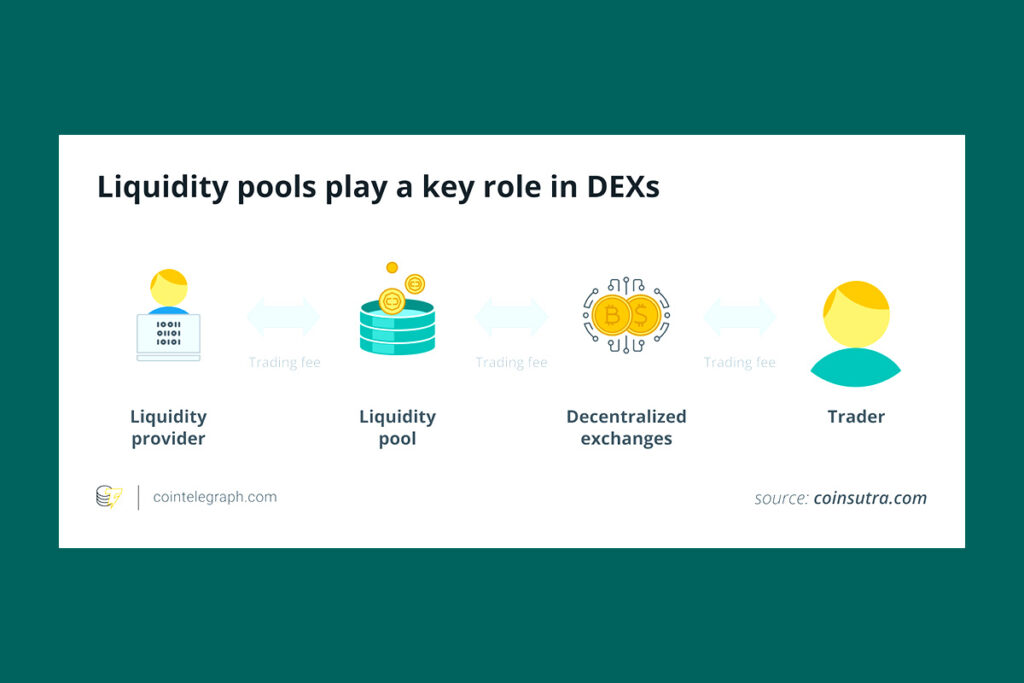Boosting Blockchain Adoption: The Impact of Crypto Liquidity Pools

Decentralized finance (DeFi) relies on crypto liquidity pools to facilitate smooth trading and financial operations without needing conventional order books. These pools let users trade directly against the liquidity offered because they are made up of cryptocurrency money that is locked in smart contracts. Through the removal of intermediaries, this novel concept produces a more decentralized and effective market structure.
Liquidity providers (LPs) furnish the liquidity pools with their assets in return for rewards, hence enabling the liquidity pools. Transaction fees or governance tokens are frequently used as these rewards, giving LPs a means of generating passive income while assisting the ecosystem. Liquidity pools secure seamless token exchanges and support the operation of DeFi platforms by preserving a steady flow of capital.
Liquidity pools, an essential part of DeFi, offer a decentralized way for blockchain projects to create marketplaces for their currencies, boosting exposure and drawing in new users. Investors also profit from a variety of options and the possibility of consistent returns. Liquidity pools fuel innovation and uptake in the cryptocurrency market.
The Hidden Dangers of Fake Liquidity Pools in Cryptocurrency
A concerning aspect of decentralized finance (DeFi) is exposed by fake liquidity pools, where fraudsters take use of the system’s decentralized structure to trick unwary investors. These scams, which are frequently carried out via rug pulls, draw attention to the weaknesses in the DeFi environment that are dependent on trust.
When cryptocurrency businesses introduce a new token, they usually link it with well-known assets like Ether (ETH), Binance Coin (BNB), or Tether’s USDt to create a liquidity pool that facilitates trading. Under normal circumstances, these pools make token trading easier, which is advantageous to the project and its investors. Malicious developers, on the other hand, establish a liquidity pool in fraudulent setups specifically to defraud investors.
Scammers entice investors to exchange precious cryptocurrencies for their new token by aggressively marketing it and offering large profits. The developers quickly remove liquidity from the pool after it has amassed a sizable amount of money, leaving investors with worthless tokens and no way to recoup their losses. The need for more attention and openness is highlighted by the fact that these dishonest tactics not only hurt individual investors but also erode confidence in the larger DeFi ecosystem.
Top Indicators of Fake Liquidity Pools Every Investor Should Know
Being vigilant and keeping an eye out for warning indicators are necessary to protect your investments against fraudulent liquidity pool schemes. A significant warning sign is the promise of irrational returns, like 100% APY or instant profits. These exaggerated statements are frequently utilized to swiftly entice investors and conceal the project’s deceptive goal.
The lack of openness about the project’s developers is another important sign. While respectable initiatives have visible, reputable developers with a track record of success, scams frequently use faceless or unverifiable teams. To guarantee authenticity, always check the team’s credentials.
Equally important is the integrity of a project’s smart contracts. Vulnerabilities and exploits might arise because fake liquidity pools usually use contracts that are either fully unaudited or inadequately audited. Robust audits are a top priority for trustworthy projects in order to guarantee security and inspire investor confidence.
Finding real initiatives also heavily relies on community involvement. While fraudulent ventures shun engagement, dodge queries, or exhibit passivity on social media, legitimate ones promote open dialogue and maintain active communities. A major warning sign is a lack of communication transparency.
Last but not least, dubious tokenomics may be a blatant sign of fraud. Projects that provide developers or insiders with an abnormally high percentage of tokens foster an atmosphere that is conducive to market manipulation. Once liquidity increases, these criminals may dump tokens, causing investors to suffer large losses. You can protect your money and create a safer environment in the decentralized finance ecosystem by being aware of these warning indicators.
Spotting Liquidity Pool Scams: Tips for Protecting Your Crypto Investments
Decentralized exchanges (DEXs) can become dangerous places for new tokens due to fake liquidity pools, but the risks can be reduced by being proactive. The key to spotting scams is carrying out comprehensive due diligence, analyzing token distribution, confirming locked liquidity, and monitoring community behavior.
Begin by doing a thorough investigation of the project. Examine the team’s identification and make sure they have backing from trustworthy cryptocurrency investors. Go for independent evaluations, Reddit threads, and social media discussions rather than depending just on the project’s main page. Platforms like X can occasionally warn of possible risks, and projects with no apparent goal other than gathering money are frequently signs of a scam.
Observe the token distribution carefully. There is a greater chance of market manipulation if a tiny percentage of the tokens are held by a few wallet addresses. To check token allocations and ensure equitable distribution, use programs such as BscScan or Etherscan.
Make sure the liquidity is protected since genuine projects guard their liquidity pools to stop developers from taking money out too soon. Scammers frequently employ short lock lengths to quickly carry out rug pulls after instilling a false sense of security, so keep an eye out for them.
Lastly, look at the community involvement in the project. Reputable initiatives keep in constant contact with their members, spreading open communication and offering frequent updates. The markers of legitimacy are responsive developers and an engaged, knowledgeable community. Inactive communities controlled by promotional accounts or bots, on the other hand, ought to arouse suspicions.
For more up-to-date crypto news, you can follow Crypto Data Space.















Leave a comment